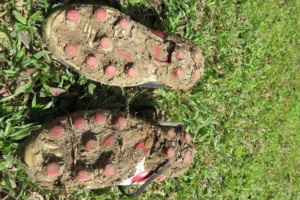
Ankle sprains are common among sports-persons and those who frequently land incorrectly. This causes the ankle to twist or roll therefore damaging the ligaments and soft tissues. It is characterized by swelling and pain in the ankle.
Did you know that 85% of youth soccer injuries are reported as ankle sprains?
Sprained Ankle: How to Avoid & How to Treat it is a crucial set of tips everyone should learn and practice. Most sprains will heal without any complications but leave an increased risk of recurrence. It is important to fully regain ankle strength, flexibility, and balance to prevent a recurrence.
Ways to avoid an ankle sprain
Balance training
When you improve your balance and give the body the ability to control itself better in all positions. Balancing on one foot is one way to build balance. It is simple, practice balancing on one foot when doing regular tasks like brushing your teeth or cooking. When this gets easy, progress to hopping on one foot.
Strengthen your ankles
Many people feel unstable around the ankles due to weak ankle muscles. Exercises and soccer cleats that strengthen the ankles muscles and especially those on the outer leg will give you strength and minimize the risks of a sprain or injuries that are more serious.
Flexibility
When you lack flexibility along the leg, high, and torso, there is a higher risk of an ankle injury. Getting into a stretching and mobility routine can help you gain adequate flexibility that could save you from ankle injuries.
Adequate preparation
Before getting into rigorous activities, it is crucial that you engage in a warm-up session. Doing light stretches or a slow jog for a minute or two will warm up your muscles. Performing unpracticed skills exposes your body to injuries since you may not know how to respond. Gradually build your activity level to prevent any injury and keep your ankles stronger. Increase the amount of time spent on these preparation activities over several weeks to give your muscles strength and mobility. You may even consider cross-training that will build several muscles.
Don’t forget shin guards with ankle support. These will reduce the possibility of sprain but will add some movement restriction.
Carefully choose your shoes
Those with low arches should consider shoes with support in the front and under the arch. These are very stable. However, if you have stiffer foot, then go for shoes with a softer platform or more cushion. Use the shoes designed for the sport you are involved in. It is recommended that you replace shoes when the treads wear off.
Avoid uneven surfaces
When running or walking on rocky terrains, you should be more careful. Uneven terrains with rocks, tree stumps, and roots are common causes of ankle sprains. Choose your surfaces and watch out where you walk or run.
Regular exercise
When you do exercises on a regular basis, you will give the ankle muscles conditioning and strength to keep you from injuries. Muscles need stretching and strengthening to give you the desired support that keeps you from ankle sprains and other serious leg injuries.
Treating ankle sprain
Around 25,000 ankle sprains occur in the United States daily. That’s more than 9 million sprains a year only in the US!
To get the best results after an ankle sprain, you need to start immediately you get the injury. The simplest way to remember the procedure is by memorizing the word RICE. This stands for getting rest, applying ice on the injury, compressing the ankle, and elevating the leg.

Rest
After an injury, the tissues around the ankle needs time to heal. When you take a rest, you will be preventing further injury and reduce the stress on the injured tissues. For severe injuries, you should consider using a crutch or walking stick to ease off the pressure on the injured ankle.
Ice
Ice has been used for a long time to reduce swelling and ease the pain on an injured part. Apply the ice as soon as you get the injury since most of the inflammation does develop immediately after an injury. Apply ice in the form of frozen peas, an ice pack, or crushed ice cubes to ensure a speedy recovery. Do not directly place ice on the skin as it can cause an ice burn.
Compression
Elastic tubular bandages can help compress an injured ankle. It will prevent inflammation and further injuries in case you have to continue walking on the injured leg. Place it from the base of the toe and extend it all the way to your shin to provide maximum support. It must not be too tight and should be taken off at night to allow your skin to breathe free.

Elevation
Place the leg at an elevation above your heart to help control the swelling. This will assist the body to reabsorb the fluids that have leaked into the tissues around the injury, therefore, minimizing the swelling. Simply lie on a couch or bed and prop the leg on a pillow or chair to keep it higher than the heart for this to work.
Massage
Severe swelling can be managed by a self-massage from the ankle towards the knee while the leg is elevated above the heart. This procedure will help remove the excess tissue fluids and reduce the swelling.
Pain reliever
Using mild pain relief medication can help reduce the discomfort and allow you to move around with as little pain as possible. The medication can also bring relief from the swelling to get you back on your feet sooner.
Use essential oils
Essential oils help reduce swelling when you get ankle sprain and injuries. As you rest, consider massaging with or just applying essential oils on the swollen tissue to help with faster healing.
Sprained Ankle Conclusion
Ankle injuries are common among those who wear the wrong shoes, walk and run on uneven surfaces and have weak ankle muscles. When you wear supportive shoes, exercise regularly, and watch out where you run, the chances of ankle injuries are minimal.
Engaging in warm-ups and muscle strengthening helps prevent injuries. In case you get injured or sprain the ankle, use the RICE procedure to get better faster. This includes resting, applying ice to the injured place, compressing the injured tissue to minimize swelling, and elevating the leg about the heart.


